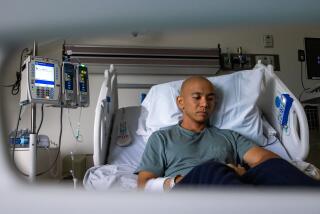Baby Awaits Critical Marrow Transplant
For 8-month-old Blayke LaRue, the blood that will be dripped into his veins this morning will be just another inconvenience, another tube coming out of him, another obstacle to hamper him from playing and crawling.
But that blood, a mere two ounces, could save the Oxnard baby’s life.
In a bone marrow transplant that doctors at UCLA Medical Center say will take no more than 30 minutes, blood extracted from the umbilical cord of another baby will be given to Blayke in the hopes of curing him of a rare genetic disease.
The actual transplant is an incredibly simple process but a risky one. Doctors will watch and wait for the next few weeks to see if the baby’s body accepts the new blood. They say his life rides on the outcome.
Today’s procedure is the climax of a weeks-long crusade by Blayke’s parents, Scott and Theresa LaRue, to encourage people to register as bone marrow donors nationally to find a life-saving match for their baby.
They had plenty of help in their efforts from police and emergency workers. Firefighters at the Alhambra Fire Department, where Scott LaRue is a paramedic, are covering his shifts and planning fund-raisers. Meanwhile, members of the Los Angeles Police Department--where the baby’s grandfather, Ron LaRue, works as a lieutenant in the North Hollywood Division--helped organize four donor drives.
On Wednesday, Blayke’s mother, weary after a 24-hour shift watching over her son, emerged from his hospital room and turned over the duty to her husband. The little boy, far too young to understand the swirl of activity around him, had had a difficult night.
“Normally he’s a happy baby,” she said. “But in here he is irritable.”
The baby hasn’t been interested in food for the last 10 days because he has been bombarded with an intense run of chemotherapy designed to kill his own compromised immune system. Instead he relies on an intravenous drip to get liquids and nutrients.
“He pushes away the bottle,” said pediatrician Madeline Marcus, one of the many doctors caring for Blayke.
Inside the sterile confines of Blayke’s room, Scott LaRue hoisted his son high and tried to coax a smile out of the boy. But the baby is uncomfortable--his mouth riddled with sores, a side effect of the chemotherapy--so smiles are rare. Mostly he saves them for his big brothers, Garrett, 3, who suffers from the same disease, and Aaron, 5, Theresa’s child from a previous marriage, who does not.
“They come by once a day,” Theresa LaRue said. “That is about the only time you see him smile.”
While UCLA doctors have performed more than 1,800 bone marrow transplants since the hospital established its transplant program, Blayke’s case marks the first time the hospital will use placental blood in the process.
Only about 160 transplants using stored blood from umbilical cords have been done worldwide. But the potential for the new process to revolutionize transplants is considerable; if banks are set up around the country to receive and store the umbilical cord blood, the number of opportunities to find a match could skyrocket.
There is talk of expanding the program, but for now, New York Blood Center’s Placental Blood Program is the only organization collecting umbilical cord blood. Extracting the blood has no effect on either the mother or the newborn child and requires nothing more than an OK from the mother before she delivers.
“This is something that is literally going to be thrown in the trash otherwise,” Marcus said.
Doctors aren’t sure why, but they believe the type of blood found in umbilical cords, particularly rich in stem cells, may carry less risk of being rejected by the patient. There is a catch though: Umbilical cords only yield enough blood for transplants in children.
Today’s transplant will be the first time doctors have tried the procedure on a patient with the disease Blayke has, X-linked lymphoproliferative disease (XLP).
The XLP disease leaves its victims unable to ward off infection and medical experts say most die before their 10th birthday. It is very rare, with only about 300 cases reported since it was discovered in the late 1960s.
Despite the disease’s rarity, the LaRues have been triply cursed by it. Last summer, before they realized their children were carrying the disease, they lost 13-month-old Layne to a quick-moving fever and infection. And they are still looking for a perfect match for Garrett, only a 1-in-20,000 chance. A possible donor was found in Finland last week, but more tests need to be run.
After today’s operation, doctors will watch Blayke for three weeks, looking for any sign of donor rejection or infection. If the transplant takes, and begins to generate new, healthy blood cells in the baby’s system, doctors say he should be fine. But if the new cells do not take, Blayke’s life will be in even greater jeopardy because his own immune system is already almost gone.






